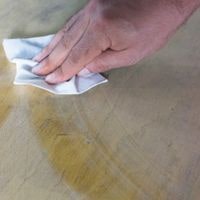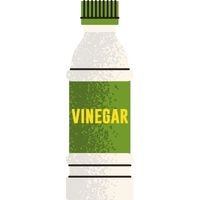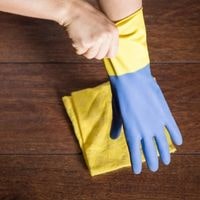How To Remove Heat Stains From Wood. It’s a popular choice of material because wood is attractive and adds a touch of style to a room.
However, this characteristic also makes it more vulnerable to stains than other types of materials used to make furniture.
The most common problem that wooden furniture can be prone to are heat staining marks which result in white marks or blemishes displaying up on your wooden furniture ‘no matter what you do’.
Here are some ways to remove heat marks from wood so you can keep your lovely natural-wood furniture stay looking brand new.
How To Remove Heat Stains From Wood
In this article, we discuss how to remove heat stains from wood.
Using Mayonnaise
Heat stains on wood can be removed with mayonnaise. Some oils, such as mayonnaise and petroleum jelly.
Work in a similar way and help release any trapped moisture in the wood pores, which causes the white stains to appear on wood furniture.
Let your wood surface dry slightly after cleaning it with lukewarm water. Rub over any dirty areas with the mayo.
Soak for a half hour or so and wipe with a clean cloth afterward to make sure there isn’t any remaining mayo residue that would make the problem worse.
Using Toothpaste
Another way to remove heat stains is by using toothpaste. For the most effective results, select white, non-gel toothpaste that doesn’t have any baking soda in it.
You can make your own paste if you want something powerful; mix toothpaste with baking soda to create a paste that will lift even the most stubborn dirt spots from a wooden surface.
You may apply it directly to a clean, dry wood surface and allow it to sit for up to ten minutes before wiping it away. Pressing too hard can cause more damage or leave an unpleasant odor behind.
Using Lemon Oil
Some people also recommend using lemon oil and fine-grade steel wool to remove heat stains. Apply a few drops of lemon oil to your furniture’s heat stains, and then follow it up with the application of a generous amount of fine-grade steel wool.
Rub the affected area back and forth in order to remove any burn marks or discoloration that is present on it.
Never use this method for wood that has not been finished, as you run the risk of damaging it permanently.
Using Steam Iron
Users have reported the most success using the iron method. First, make sure you’ve cleaned your wooden table or other affected surface with a slightly damp cloth so it’s completely dust-free.
Then, place a cotton towel over the stained area and turn your iron onto a low heat setting. Place it onto the towel do not put it directly on the table as it could leave marks in some cases depending on how hot you make it.
Leave it for a short period before checking back to see if there is any change. The use of an old towel will protect your furniture from being damaged in this process – but be careful not to set the temperature too high or else you might burn your heat stain area.
Using Vinegar
Vinegar can help you clean heat-stain wood furniture. Pour vinegar over the surface and all of the stains will come out. Let it dry either outside or in the sun.
Then, mix equal parts oil and vinegar in a sealable container and apply with a clean cloth to all areas that need to be cleaned.
All of the dirt will wipe off easily with this method since oil has a strong cleaning power and vinegar dissolves dirt easily.
FAQs
Heat stains on the wood are permanent, right?
Wood furniture is susceptible to stain, especially water and heat damage. These two things are often the reasons for white spots on wood furniture.
If a hot item such as a pizza box or frying pan were placed directly onto the wood finish, it could cause white spots that cannot be removed with just one method.
